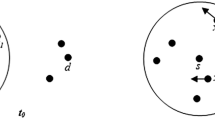Abstract
We analyze the problem of finding an energy-efficient path from a source node to a destination using geographic routing. Existing schemes have neglected the fact that neighbors which are not closer to the destination than the current node can still reduce energy consumption by taking part in the selected path. Moreover, recent works have confirmed that the generally used Unit Disk Graph to model Wireless Sensor Networks does not represent accurately the behavior of real links. We propose a new scheme called Locally Optimal Source Routing (LOSR) that is able to use neighbors which do not provide advance toward the destination to reduce the overall energy consumption while still avoiding routing loops. Using an Automatic Repeat reQuest (ARQ) mechanism hop by hop we overcome the problems caused by errors in radio transmissions and we introduce a novel routing metric, which accounts for those errors in the energy consumption. Our simulation results show that the proposed scheme outperforms existing solutions over a variety of scenarios and network densities.
Similar content being viewed by others
References
Bondy, J. A., & Murty, U. S. R. (1976). Graph theory with applications. London: Macmillan.
Bose, P., Morin, P., Stojmenovic, I., & Urrutia, J. (2001). Routing with guaranteed delivery in ad hoc wireless networks. Wireless Networks, 7(6), 609–616.
Datta, S., Stojmenovic, I., & Wu, J. (2001). Internal node and shortcut based routing with guaranteed delivery in wireless networks. In Proc. 21st international conference on distributed computing systems (ICDCSW ’01) (p. 461). Washington, DC, USA: IEEE Computer Society.
Finn, G. G. (1987). Routing and Addressing Problems in Large Metropolitan-Scale Internetworks. Tech. Rep. ISI/RR-87-180, University of Southern California, Information Sciences Institute.
Gabriel, K., & Sokal, R. (1969). A new statistical approach to geographic variation analysis. Systematic Zoology, 18, 259–278.
Giordano, S., Stojmenovic, I., & Blazevic, L. (2004). Position based routing algorithms for ad hoc networks: A taxonomy. In X.␣Cheng, X. Huang, & D. Z. Du (Eds.), Ad hoc wireless networking (pp. 103–136). Kluwer.
Haque, I. T., Assi, C., & Atwood, J. W. (2005). Randomized energy aware routing algorithms in mobile ad hoc networks. In Proc. 8th ACM International Symposium on Modeling, Analysis and Simulation of Wireless and Mobile Systems (MSWiM ’05) (pp. 71–78). New York, NY, USA: ACM Press.
Heinzelman, W. R., Chandrakasan, A., & Balakrishnan, H. (2000). Energy-efficient communication protocol for wireless microsensor networks. In Proc. 33rd Annual Hawaii International Conference on System Sciences (HICSS ’00).
Hou, T.-C. & Victor Li (1986). Transmission range control in multihop packet radio networks. IEEE Transactions on Communications [legacy, pre-1988], 34(1), 38–44.
Karl, H., & Willig, A. (2005). Protocols and architectures for wireless sensor networks. John Wiley & Sons.
Karp, B., & Kung, H. T. (2000) GPSR: greedy perimeter stateless routing for wireless networks. In Proc. 6th Annual ACM/IEEE International Conference on Mobile Computing and Networking (MobiCom ’00) (pp. 243–254). New York, NY, USA: ACM Press.
Kuruvila, J., Nayak, A., & Stojmenovic, I. (2001). Progress and location based localized power aware routing for ad hoc and sensor wireless networks. IEEE Transactions on Parallel and Distributed Systems, 12(11), 1122–1133.
Kuruvila, J., Nayak, A., & Stojmenovic, I. (2005). Hop count optimal position based packet routing algorithms for ad hoc wireless networks with a realistic physical layer. IEEE Journal on Selected Areas in Communications, 23(6), 1267–1275.
Kuruvila, J., Nayak, A., Stojmenovic, I. (2006). Greedy localized routing for maximizing probability of delivery in wireless ad hoc networks with a realistic physical layer. Journal of Parallel Distributed Computing, 66(4), 499–506.
Lee, S., Bhattacharjee, B., & Banerjee, S. (2005). Efficient geographic routing in multihop wireless networks. In Proc. 6th ACM International Symposium on Mobile Ad Hoc Networking and Computing (MobiHoc ’05), pp. 230–241.
Pottie, G. J., & Kaiser, W. J. (2000). Wireless integrated network sensors. Communications of the ACM, 43(5), 51–58.
Rodoplu, V., & Meng, T. H. (1999). Minimum energy mobile wireless networks. IEEE Journal on Selected Areas in Communications, 17(8), 1333–1344.
Seada, K., Zuniga, M., & Helmy, A., & Krishnamachari, B. (2004). Energy-efficient forwarding strategies for geographic routing in lossy wireless sensor networks. In Proc. 2nd International Conference on Embedded Networked Sensor Systems (SenSys ’04) (pp. 108–121). New York, NY, USA: ACM Press.
Singh, S., Woo, M., & Raghavendra, C. S. (1998). Power-aware routing in mobile ad hoc networks. In Proc. 4th annual ACM/IEEE International Conference on Mobile Computing and Networking (MobiCom ’98) (pp. 181–190). New York, NY, USA: ACM Press.
Stojmenovic, I., & Lin, X. (2001). Power-aware localized routing in wireless networks. IEEE Transactions on Paralell and Distributed Systems, 12(10), 1122–1133.
Toussaint, G. T. (1980). The relative neighborhood graph of a finite planar set. Pattern Recognition, 12, 261–268.
Woo, A., Tong, T., & Culler, D. (2003). Taming the underlying challenges of reliable multihop routing in sensor networks. In Proc. First International Conference on Embedded Networked Sensor Systems (SenSys ’03) (pp. 14–27). New York, NY, USA: ACM Press.
Zhao, J., & Govindan, R. (2003). Understanding packet delivery performance in dense wireless sensor networks. In Proc. First International Conference on Embedded Networked Sensor Systems (SenSys ’03) (pp. 1–13). New York, NY, USA: ACM Press.
Acknowledgments
This work was supported in part by the Spanish MEC by means of the “Ramon y Cajal“ Research Program, and in part by the SMART TIN2005-07705-C02-02 Project.
Author information
Authors and Affiliations
Corresponding author
Rights and permissions
About this article
Cite this article
Sanchez, J.A., Ruiz, P.M. Locally Optimal Source Routing for energy-efficient geographic routing. Wireless Netw 15, 513–523 (2009). https://doi.org/10.1007/s11276-007-0066-1
Published:
Issue Date:
DOI: https://doi.org/10.1007/s11276-007-0066-1




